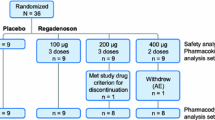Abstract
Although caffeine attenuates the vasodilatation produced by dipyridamole and adenosine, and is therefore contraindicated when these agents are used for myocardial perfusion scintigraphy, caffeine levels in clinical patients undergoing standard imaging protocols have not been studied. Eighty-six patients undergoing clinically indicated intravenous dipyridamole (n=75) or adenosine (n=11) thallium-201 myocardial perfusion scintigraphy, all of whom reported abstention from products containing caffeine for 24 h, were studied prospectively. Blood samples were drawn prior to initiation of the pharmacologic infusion, and serum caffeine levels were determined using an enzyme immunoassay technique. Results of these determinations were correlated with maximum pulse and blood pressure changes measured during and immediately after the stressor infusion, and thallium imaging findings. Detectable caffeine levels were found in 34 patients (40%), ranging from 0.1 to 5.0 mg/l. There was no significant difference in mean systolic blood pressure decrease or mean pulse increase between patients with caffeine levels > 1.0 mg/l (20.4 ± 18.2 mmHg, 11.0 ± 8.9 BPM; n=5) and those with lower (0.1 to 0.9 mg/1) (15.4 ± 9.5 mmHg, 14.4 ± 8.2 BPM; n=29) or no detectable caffeine levels (18.0 ± 11.5 mmHg, 16.6 ± 10.1 BPM; n=52). Redistribution on thallium imaging was also identified with a similar frequency in these three groups (2/5, 40%; 8/29, 28%; 22/52, 42% respectively).
Similar content being viewed by others
References
Ranhosky A, Kempthorne-Rawson J, and the Intravenous Dipyridamole Thallium Imaging Study Group. (1990): The safety of intravenous dipyridamole thallium myocardial perfusion imaging. Circulation 1990;81: 1205–1209.
Taillefer R, Lette J, Phaneuf D-C, et al. Thallium-201 myocardial imaging during coronary vasodilation: comparison of oral and intravenous administration of dipyridamole. J Am Coll Cardiol 1986;8: 76–83.
Verani MS, Mahmarian JJ, Hixson JB, et al. Diagnosis of coronary artery disease by controlled coronary vasodilation with adenosine and thallium-201 scintigraphy in patients unable to exercise. Circulation 1990;82: 80–87.
Abreu A, Mahmarian JJ, Nishimura S, et al. Tolerance and safety of pharmacologic coronary vasodilation with adenosine in association with thallium-201 scintigraphy in patients with suspected coronary artery disease. J Am Coll Cardiol 1991;18: 730–735.
Sollevi A, Ostergren J, Fagrell B, et al. Theophylline antagonizes cardiovascular responses to dipyridamole in man without affecting increases in plasma adenosine. Acta Physiol Scand 1984;121: 165–171.
Daley PJ, Mahn TH, Zielonka JS, et al. Effect of maintenance oral theophylline on dipyridamole-thallium-201 myocardial imaging using SPECT and dipyridamole-induced hemodynamic changes. Am Heart J 1988;115: 1185–1192.
Smits P, Lenders J, Thien T. Caffeine and theophylline attenuate adenosine-induced vasodilation in man. Clinical Pharmacol Ther 1990;48: 410–418.
Smits P, Thien T, van't Laar A. Circulatory effects of coffee in relation to the pharmacokinetics of caffeine. Am J Cardiol 1985;56: 958–963.
Smits P, Boekema P, De Abreu R, et al. Evidence for an antagonism between caffeine and adenosine in the human cardiovascular system. J Cardiovasc Pharmacol 1987;10: 136–143.
Smits P, Aengevaeren WRM, Corstens FHM, et al. Caffeine reduces dipyridamole-induced myocardial ischemia. J Nucl Med 1989;30: 1723–1726.
Smits P, Corstens FHM, Aengevaeren WRM, et al. False-negative dipyridamole thallium-201 myocardial imaging after caffeine infusion. J Nucl Med 1991;32: 1538–1541.
Statland BE, Demas TJ, Danis M. Caffeine accumulation associated with alcoholic liver disease. Am J Med 1976;295: 110–111.
Statland BE, Demas TJ. Serum caffeine half-lives. Healthy subjects vs patients having alcohol hepatic disease. Am J Clin Pathol 1980;73: 390–393.
Rall TW. Drugs used in the treatment of asthma. The methylxanthines, cromolyn sodium, and other agents. In: Gilman AG, Rall TW, Nies AS, Taylor P, eds. The pharmacologic basis of therapeutics, 8th edn. New York: Pergamon Press; 1990:618–637.
Author information
Authors and Affiliations
Additional information
Correspondence to: A.F. Jacobson
Rights and permissions
About this article
Cite this article
Jacobson, A.F., Cerqueira, M.D., Raisys, V. et al. Serum caffeine levels after 24 hours of caffeine abstention: observations on clinical patients undergoing myocardial perfusion imaging with dipyridamole or adenosine. Eur J Nucl Med 21, 23–26 (1994). https://doi.org/10.1007/BF00182302
Revised:
Issue Date:
DOI: https://doi.org/10.1007/BF00182302




